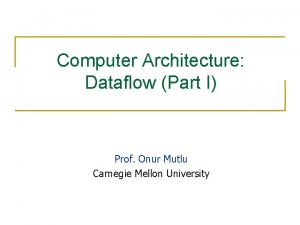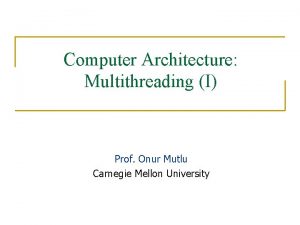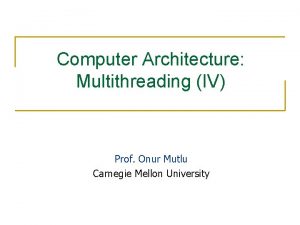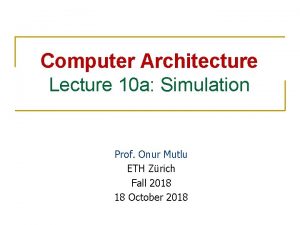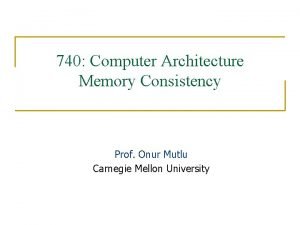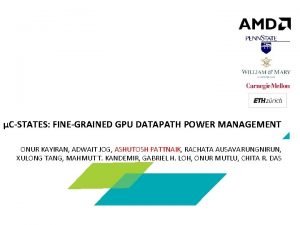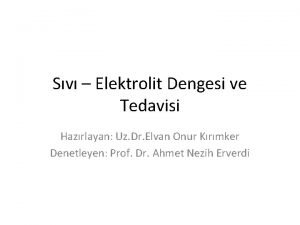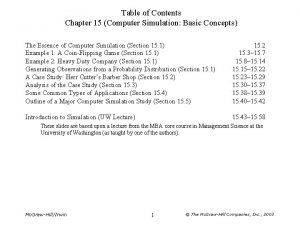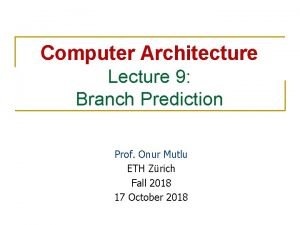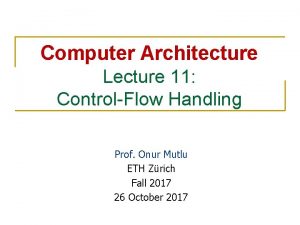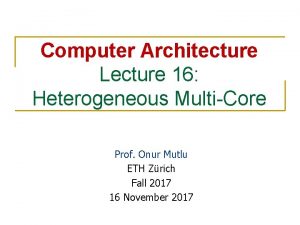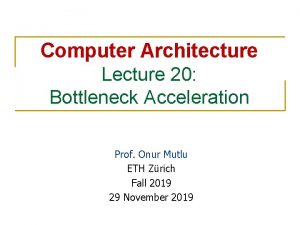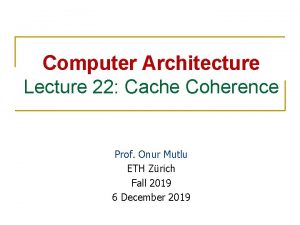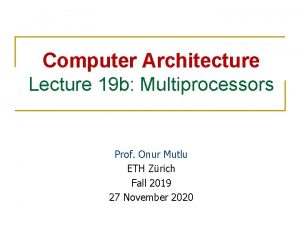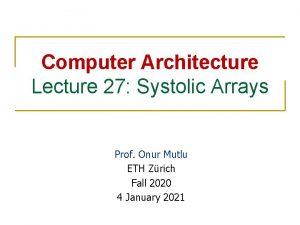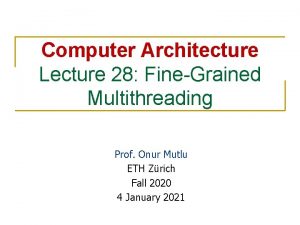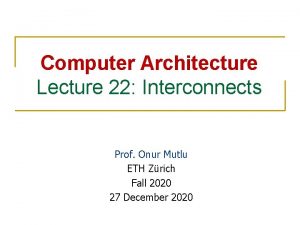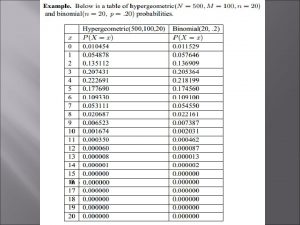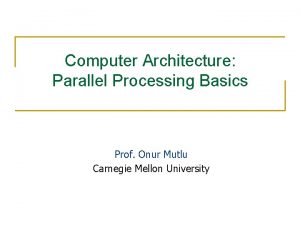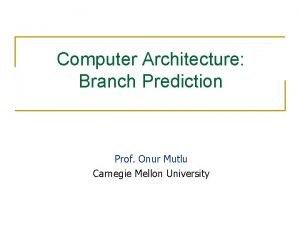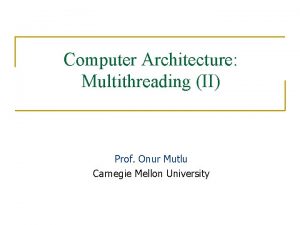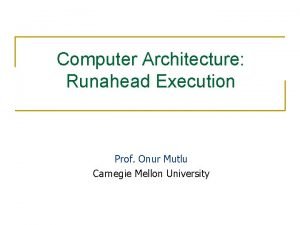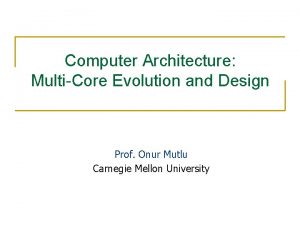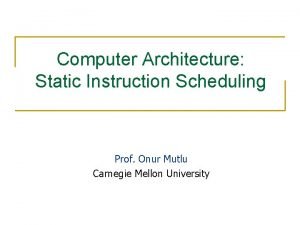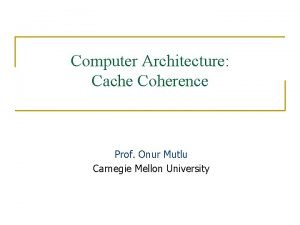Computer Architecture Lecture 10 a Simulation Prof Onur


















![Ramulator: A Fast and Extensible DRAM Simulator [IEEE Comp Arch Letters’ 15] 19 Ramulator: A Fast and Extensible DRAM Simulator [IEEE Comp Arch Letters’ 15] 19](https://slidetodoc.com/presentation_image/0342a710ac88ddf2340e1a62f2d49a78/image-19.jpg)






- Slides: 25

Computer Architecture Lecture 10 a: Simulation Prof. Onur Mutlu ETH Zürich Fall 2018 18 October 2018

Continuing Memory Lectures n n n n Main Memory Challenges Main Memory Fundamentals DRAM Basics and Operation Memory Controllers Simulation Memory Latency In-Memory Computation – Processing in Memory 2

Recall: Reality and Dream n n Reality: It difficult to optimize all these different constraints while maximizing performance, Qo. S, energy-efficiency, … Dream: Wouldn’t it be nice if the DRAM controller automatically found a good scheduling policy on its own? 3

Recall: Self-Optimizing DRAM Controllers n Dynamically adapt the memory scheduling policy via interaction with the system at runtime q q q Associate system states and actions (commands) with long term reward values: each action at a given state leads to a learned reward Schedule command with highest estimated long-term reward value in each state Continuously update reward values for <state, action> pairs based on feedback from system 4

More on Self-Optimizing DRAM Controllers Engin Ipek, Onur Mutlu, José F. Martínez, and Rich Caruana, n "Self Optimizing Memory Controllers: A Reinforcement Learning Approach" Proceedings of the 35 th International Symposium on Computer Architecture (ISCA), pages 39 -50, Beijing, China, June 2008. 5

Simulating Memory 6

Evaluating New Ideas for New (Memory) Architectures

Potential Evaluation Methods n How do we assess an idea will improve a target metric X? n A variety of evaluation methods are available: q Theoretical proof q Analytical modeling/estimation q Simulation (at varying degrees of abstraction and accuracy) q Prototyping with a real system (e. g. , FPGAs) q Real implementation 8

The Difficulty in Architectural Evaluation n The answer is usually workload dependent q q q E. g. , think caching E. g. , think pipelining E. g. , think any idea we talked about (RAIDR, Mem. Sched. , …) n Workloads change n System has many design choices and parameters q q n Architect needs to decide many ideas and many parameters for a design Not easy to evaluate all possible combinations! System parameters may change 9

Simulation: The Field of Dreams

Dreaming and Reality n An architect is in part a dreamer, a creator n Simulation is a key tool of the architect n Simulation enables q q q n The exploration of many dreams A reality check of the dreams Deciding which dream is better Simulation also enables q The ability to fool yourself with false dreams 11

Why High-Level Simulation? n Problem: RTL simulation is intractable for design space exploration too time consuming to design and evaluate q q q Especially over a large number of workloads Especially if you want to predict the performance of a good chunk of a workload on a particular design Especially if you want to consider many design choices n n n Cache size, associativity, block size, algorithms Memory control and scheduling algorithms In-order vs. out-of-order execution Reservation station sizes, ld/st queue size, register file size, … … Goal: Explore design choices quickly to see their impact on the workloads we are designing the platform for 12

Different Goals in Simulation n Explore the design space quickly and see what you want to q q q n Match the behavior of an existing system so that you can q q q n potentially implement in a next-generation platform propose as the next big idea to advance the state of the art the goal is mainly to see relative effects of design decisions debug and verify it at cycle-level accuracy propose small tweaks to the design that can make a difference in performance or energy the goal is very high accuracy Other goals in-between: q q Refine the explored design space without going into a full detailed, cycle-accurate design Gain confidence in your design decisions made by higher-level design space exploration 13

Tradeoffs in Simulation n Three metrics to evaluate a simulator q q q n n Speed Flexibility Accuracy Speed: How fast the simulator runs (x. IPS, x. CPS, slowdown) Flexibility: How quickly one can modify the simulator to evaluate different algorithms and design choices? Accuracy: How accurate the performance (energy) numbers the simulator generates are vs. a real design (Simulation error) The relative importance of these metrics varies depending on where you are in the design process (what your goal is) 14

Trading Off Speed, Flexibility, Accuracy n Speed & flexibility affect: q n Accuracy affects: q q n How good your design tradeoffs may end up being How fast you can build your simulator (simulator design time) Flexibility also affects: q n How quickly you can make design tradeoffs How much human effort you need to spend modifying the simulator You can trade off between the three to achieve design exploration and decision goals 15

High-Level Simulation n n Key Idea: Raise the abstraction level of modeling to give up some accuracy to enable speed & flexibility (and quick simulator design) Advantage + Can still make the right tradeoffs, and can do it quickly + All you need is modeling the key high-level factors, you can omit corner case conditions + All you need is to get the “relative trends” accurately, not exact performance numbers n Disadvantage -- Opens up the possibility of potentially wrong decisions -- How do you ensure you get the “relative trends” accurately? 16

Simulation as Progressive Refinement n High-level models (Abstract, C) n … Medium-level models (Less abstract) … Low-level models (RTL with everything modeled) … Real design n As you refine (go down the above list) n n n q q Abstraction level reduces Accuracy (hopefully) increases (not necessarily, if not careful) Flexibility reduces; Speed likely reduces except for real design You can loop back and fix higher-level models 17

Making The Best of Architecture n A good architect is comfortable at all levels of refinement q n A good architect knows when to use what type of simulation q n Including the extremes And, more generally, what type of evaluation method Recall: A variety of evaluation methods are available: q q q Theoretical proof Analytical modeling Simulation (at varying degrees of abstraction and accuracy) Prototyping with a real system (e. g. , FPGAs) Real implementation 18
![Ramulator A Fast and Extensible DRAM Simulator IEEE Comp Arch Letters 15 19 Ramulator: A Fast and Extensible DRAM Simulator [IEEE Comp Arch Letters’ 15] 19](https://slidetodoc.com/presentation_image/0342a710ac88ddf2340e1a62f2d49a78/image-19.jpg)
Ramulator: A Fast and Extensible DRAM Simulator [IEEE Comp Arch Letters’ 15] 19

Ramulator Motivation n n DRAM and Memory Controller landscape is changing Many new and upcoming standards Many new controller designs A fast and easy-to-extend simulator is very much needed 20

Ramulator n Provides out-of-the box support for many DRAM standards: q n n DDR 3/4, LPDDR 3/4, GDDR 5, WIO 1/2, HBM, plus new proposals (SALP, AL-DRAM, TLDRAM, Row. Clone, and SARP) ~2. 5 X faster than fastest open-source simulator Modular and extensible to different standards 21

Case Study: Comparison of DRAM Standards Across 22 workloads, simple CPU model 22

Ramulator Paper and Source Code n n Yoongu Kim, Weikun Yang, and Onur Mutlu, "Ramulator: A Fast and Extensible DRAM Simulator" IEEE Computer Architecture Letters (CAL), March 2015. [Source Code] Source code is released under the liberal MIT License q https: //github. com/CMU-SAFARI/ramulator 23

Extra Credit Assignment n Review the Ramulator paper q n Download and run Ramulator q q n Online on our review site Compare DDR 3, DDR 4, SALP, HBM for the libquantum benchmark (provided in Ramulator repository) Upload your brief report to Moodle This may become part of a future homework 24

Computer Architecture Lecture 10 a: Simulation Prof. Onur Mutlu ETH Zürich Fall 2018 18 October 2018
 Data flow architecture
Data flow architecture Computer architecture onur mutlu
Computer architecture onur mutlu Prof. onur mutlu
Prof. onur mutlu Onur mutlu computer architecture
Onur mutlu computer architecture Onur mutlu computer architecture
Onur mutlu computer architecture Rahmi onur iletişim
Rahmi onur iletişim Computer architecture notes
Computer architecture notes Computer architecture lecture
Computer architecture lecture 01:640:244 lecture notes - lecture 15: plat, idah, farad
01:640:244 lecture notes - lecture 15: plat, idah, farad Onur alakas
Onur alakas Onur kayiran
Onur kayiran Terdilat
Terdilat Onur erkal
Onur erkal Düzeltilmiş kalsiyum
Düzeltilmiş kalsiyum Abbas polat
Abbas polat Tibbi atik amblemi bulunmasi zorunlu alanlar
Tibbi atik amblemi bulunmasi zorunlu alanlar Bus architecture in computer architecture
Bus architecture in computer architecture Computer architecture vs computer organization
Computer architecture vs computer organization Basic computer organization and design
Basic computer organization and design Computer simulation
Computer simulation Computer simulation
Computer simulation Computer security 161 cryptocurrency lecture
Computer security 161 cryptocurrency lecture Computer aided drug design lecture notes
Computer aided drug design lecture notes The architecture business cycle
The architecture business cycle Data centered architecture
Data centered architecture Modular architecture vs integrated architecture
Modular architecture vs integrated architecture
